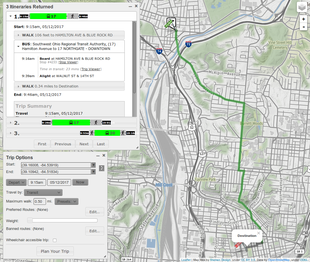
Back مخطط الرحلة Arabic Marşrut planalma Azerbaijani Plánovač cest Czech Routenplaner German Planificador de rutas Spanish Routeplanner Dutch Routeplanner Polish Ruttplanering Swedish
This article needs additional citations for verification. (May 2017) |

A journey planner, trip planner, or route planner is a specialized search engine used to find an optimal means of travelling between two or more given locations, sometimes using more than one transport mode.[1][2] Searches may be optimized on different criteria, for example fastest, shortest, fewest changes, cheapest.[3] They may be constrained, for example, to leave or arrive at a certain time, to avoid certain waypoints, etc. A single journey may use a sequence of several modes of transport, meaning the system may know about public transport services as well as transport networks for private transportation. Trip planning or journey planning is sometimes distinguished from route planning,[4] which is typically thought of as using private modes of transportation such as cycling, driving, or walking, normally using a single mode at a time. Trip or journey planning, in contrast, would make use of at least one public transport mode which operates according to published schedules; given that public transport services only depart at specific times (unlike private transport which may leave at any time), an algorithm must therefore not only find a path to a destination, but seek to optimize it so as to minimize the waiting time incurred for each leg. In European Standards such as Transmodel, trip planning is used specifically to describe the planning of a route for a passenger, to avoid confusion with the completely separate process of planning the operational journeys to be made by public transport vehicles on which such trips are made.
Trip planners have been widely used in the travel industry since the 1970s, by booking agents.[5] The growth of the internet, the proliferation of geospatial data, and the development of information technologies generally has led to the rapid development of many self-service app or browser-based, on-line intermodal trip planners.
A trip planner may be used in conjunction with ticketing and reservation systems.
- ^ Cite error: The named reference
:1was invoked but never defined (see the help page). - ^ Zografos, Konstantinos; Spitadakis, Vassilis; Androutsopoulos, Konstantinos (2008-12-01). "Integrated Passenger Information System for Multimodal Trip Planning". Transportation Research Record: Journal of the Transportation Research Board. 2072: 20–29. doi:10.3141/2072-03. ISSN 0361-1981. S2CID 109396014.
- ^ "Bike Triangle | OpenTripPlanner". GitHub. Retrieved 2017-05-11.
- ^ Bast, Hannah; Delling, Daniel; Goldberg, Andrew; Müller-Hannemann, Matthias; Pajor, Thomas; Sanders, Peter; Wagner, Dorothea; Werneck, Renato F. (2016-01-01). Kliemann, Lasse; Sanders, Peter (eds.). Algorithm Engineering. Lecture Notes in Computer Science. Springer International Publishing. pp. 19–80. arXiv:1504.05140. doi:10.1007/978-3-319-49487-6_2. ISBN 9783319494869. S2CID 14384915.
- ^ "TravelTecnik Consultants - Travel & Hospitality Technology: History of Global Distribution Systems (GDS)". Traveltecnik.com. Retrieved 2018-09-25.